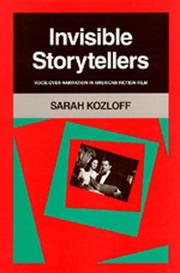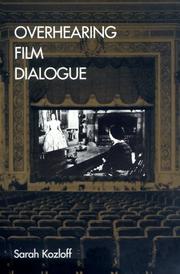| Listing 1 - 10 of 11 | << page >> |
Sort by
|

ISBN: 0520058615 9780520067936 Year: 1988 Publisher: Berkeley, Calif. University of California Press
Abstract | Keywords | Export | Availability | Bookmark
 Loading...
Loading...Choose an application
- Reference Manager
- EndNote
- RefWorks (Direct export to RefWorks)
Film --- United States --- 82:791.43 --- 791.43 --- Motion picture plays --- -Motion pictures --- -Voice-overs --- #SBIB:309H1321 --- #SBIB:309H523 --- Voiceovers --- Motion pictures --- Television announcing --- Cinema --- Feature films --- Films --- Movies --- Moving-pictures --- Audio-visual materials --- Mass media --- Performing arts --- Film plays --- Film scripts --- Filmscripts --- Motion picture scripts --- Moving-picture plays --- Photoplays --- Scenarios --- Screen plays --- Screenplays --- Scripts (Motion pictures) --- Drama --- Literatuur en film --- Filmkunst. Films. Cinema --- History and criticism --- Films met een amusementsfunctie en/of esthetische functie: algemeen --- Audiovisuele communicatie: verhaalanalyse --- 82:791.43 Literatuur en film --- 791.43 Filmkunst. Films. Cinema --- Motion picture plays, American --- Voice-overs --- United States of America

ISBN: 0520221389 0520221370 9780520221383 Year: 2000 Publisher: Berkeley, Calif. University of California Press
Abstract | Keywords | Export | Availability | Bookmark
 Loading...
Loading...Choose an application
- Reference Manager
- EndNote
- RefWorks (Direct export to RefWorks)
Since the birth of cinema, film has been lauded as a visual rather than a verbal medium; this sentiment was epitomized by John Ford's assertion in 1964 that, ""When a motion picture is at its best, it is long on action and short on dialogue."" Little serious work has been done on the subject of film dialogue, yet what characters say and how they say it has been crucial to our experience and understanding of every film since the coming of sound.
Translation science --- Film --- Dialogue in motion pictures. --- 82:791.43 --- 82:791.43 Literatuur en film --- Literatuur en film --- Dialogue in motion pictures --- Film dialogue --- Movie dialogue --- Motion pictures --- Pragmatics --- CDL --- 791.44

ISBN: 0520067932 Year: 2010 Publisher: Berkeley, Calif. University of California Press
Abstract | Keywords | Export | Availability | Bookmark
 Loading...
Loading...Choose an application
- Reference Manager
- EndNote
- RefWorks (Direct export to RefWorks)
Motion picture plays --- Motion pictures --- Voice-overs --- Scénarios de cinéma --- Cinéma --- Voix hors champ --- History and criticism --- Histoire et critique --- Film --- United States --- United States of America

ISBN: 0520924029 1597347922 9780520924024 0585394636 9780585394633 9780520221376 0520221370 9780520221383 0520221389 0520221370 0520221389 9781597347921 Year: 2000 Publisher: Berkeley : University of California Press,
Abstract | Keywords | Export | Availability | Bookmark
 Loading...
Loading...Choose an application
- Reference Manager
- EndNote
- RefWorks (Direct export to RefWorks)
Since the birth of cinema, film has been lauded as a visual rather than a verbal medium; this sentiment was epitomized by John Ford's assertion in 1964 that, ""When a motion picture is at its best, it is long on action and short on dialogue."" Little serious work has been done on the subject of film dialogue, yet what characters say and how they say it has been crucial to our experience and understanding of every film since the coming of sound.
Dialogue in motion pictures. --- Dialogue in motion pictures --- Film --- Music, Dance, Drama & Film --- Film dialogue --- Movie dialogue --- Motion pictures
Book
ISBN: 1927852307 1927852005 1927852013 Publisher: caboose
Abstract | Keywords | Export | Availability | Bookmark
 Loading...
Loading...Choose an application
- Reference Manager
- EndNote
- RefWorks (Direct export to RefWorks)
Book
ISBN: 1282355600 9786612355608 0520909666 9780520909663 9781282355606 Year: 1988 Publisher: Berkeley : University of California Press,
Abstract | Keywords | Export | Availability | Bookmark
 Loading...
Loading...Choose an application
- Reference Manager
- EndNote
- RefWorks (Direct export to RefWorks)
"Let me tell you a story," each film seems to offer silently as its opening frames hit the screen. But sometimes the film finds a voice-an off-screen narrator-for all or part of the story. From Wuthering Heights and Double Indemnity to Annie Hall and Platoon, voice-over narration has been an integral part of American movies.Through examples from films such as How Green Was My Valley, All About Eve, The Naked City, and Barry Lyndon, Sarah Kozloff examines and analyzes voice-over narration. She refutes the assumptions that words should only play a minimal role in film, that "showing" is superior to "telling," or that the technique is inescapably authoritarian (the "voice of god"). She questions the common conception that voice-over is a literary technique by tracing its origins in the silent era and by highlighting the influence of radio, documentaries, and television. She explores how first-person or third-person narration really affects a film, in terms of genre conventions, viewer identification, time and nostalgia, subjectivity, and reliability. In conclusion she argues that voice-over increases film's potential for intimacy and sophisticated irony.
Voice-overs. --- Motion picture plays, American --- Motion pictures --- History and criticism. --- adaptation theory. --- adaptations. --- all about eve. --- annie hall. --- barry lyndon. --- book to movie. --- documentary film. --- double indemnity. --- exposition. --- film adaptation. --- film criticism. --- film interpretation. --- film studies. --- film technique. --- film theory. --- film. --- filmmaking. --- how green was my valley. --- literature. --- media. --- naked city. --- narration. --- narrative theory. --- narrative. --- newsreels. --- nonfiction. --- opening frames. --- platoon. --- popular culture. --- radio. --- red river. --- silent film. --- storytelling. --- television. --- tv. --- voice over. --- wuthering heights.
Book
ISBN: 1474416144 1474406564 9781474406567 9781474406574 1474406572 9781474406550 1474406556 Year: 2015 Publisher: Edinburgh : Edinburgh University Press,
Abstract | Keywords | Export | Availability | Bookmark
 Loading...
Loading...Choose an application
- Reference Manager
- EndNote
- RefWorks (Direct export to RefWorks)
This first collection of critical essays on Preston Sturges - director, screenwriter, comic genius of Hollywood - reawakens interest in the filmmaker's life and works and reminds readers why his movies continue to be culturally significant and immensely enjoyable.
Motion picture producers and directors. --- Directors, Motion picture --- Film directors --- Film producers --- Filmmakers --- Motion picture directors --- Moviemakers --- Moving-picture producers and directors --- Producers, Motion picture --- Persons --- Sturges, Preston --- Biden, Edmund Preston --- Sturges, Preston, --- Criticism and interpretation. --- PERFORMING ARTS / Film & Video / Direction & Production.
Dissertation
Year: 1984 Publisher: Ann Arbor University microfilms international
Abstract | Keywords | Export | Availability | Bookmark
 Loading...
Loading...Choose an application
- Reference Manager
- EndNote
- RefWorks (Direct export to RefWorks)
Digital
ISBN: 9781474406567 Year: 2015 Publisher: Edinburgh Edinburgh University Press
Abstract | Keywords | Export | Availability | Bookmark
 Loading...
Loading...Choose an application
- Reference Manager
- EndNote
- RefWorks (Direct export to RefWorks)
Book
ISBN: 9781844573264 1844573265 Year: 2011 Publisher: New York Palgrave Macmillan on behalf of British Film Institute
Abstract | Keywords | Export | Availability | Bookmark
 Loading...
Loading...Choose an application
- Reference Manager
- EndNote
- RefWorks (Direct export to RefWorks)
"Due to its popularity and the controversy it engendered, The Best Years of Our Lives stands as one of the most important cultural documents of the post-WWII era. Moreover, with its emphasis on soldiers returning from war with post-traumatic stress syndrome, facing an uncertain economic climate, and strained domestic lives, the film speaks with emotional power directly to contemporary issues, including the devastating injuries and insecurites faced by soldiers returning home from combat in Afghanistan and Iraq today. Among the topics discussed are American neorealism, aesthetics, war and homecoming, and more"--Provided by publisher. William Wyler's The Best Years of Our Lives (1946) tells the story of three veterans returning from World War II and adjusting to civilian life in a manner unusual for classical Hollywood cinema, with melodrama leavened by authentic detail, personal memories and a fierce desire to capture its historical moment. Sarah Kozloff's illuminating study of the film traces the contribution of Wyler (himself injured while serving in the US Air Force), Robert Sherwood's screenplay, Gregg Toland's deep-focus cinematography, Hugo Friedhofer's award-winning score, and the ensemble cast of Myrna Loy, Fredric March, Dana Andrews, Teresa Wright and Harold Russell. The film's poignant message spoke to American audiences reeling from the end of the conflict and the bumpy transition to peace: producer Samuel Goldwyn received hundreds of letters from ex-servicemen about how accurately his production had captured their experiences.Despite winning nine Academy Awards, Best Years was soon engulfed in political conflict from both the right and the left. Disagreements about the film's politics foreshadowed HUAC's anti-Communist investigations and the fracturing of the Hollywood community that culminated in the collapse of the studio system. Sarah Kozloff's discussion of the film's development, production and reception history draws on archival research to shed new light on our understanding of this much-loved movie, and to bring The Best Years of Our Lives back where it belongs: in our collections, in our libraries, and in our hearts.(Provided by publisher)
Combat Disorders --- Stress Disorders, Post-Traumatic --- Military Personnel --- Motion Pictures --- World War II --- Best years of our lives (Motion picture) --- United States.
| Listing 1 - 10 of 11 | << page >> |
Sort by
|

 Search
Search Feedback
Feedback About UniCat
About UniCat  Help
Help News
News